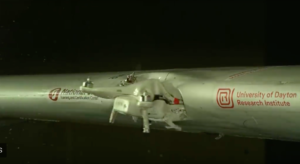The University of Dayton Research Institute recently released a video showing that when a Phantom 2 quadcopter hits the wing of an aircraft directly, bad things happen. The internet and news media, unsurprisingly, have gone to town: “Devastating Damage,” “Serious Damage,” and “Growing Risk” are all part of the headlines. But what does this latest test really prove, and what does this latest piece of publicity mean for the drone industry?
Here’s what happened: “In a test designed to mimic a midair collision at 238 miles per hour, researchers in UDRI’s Impact Physics group launched a 2.1-pound DJI Phantom 2 quadcopter at the wing of a Mooney M20 aircraft. The drone did not shatter on impact, but tore open the leading edge of the wing as it bore into the structure, damaging its main spar. “While the quadcopter broke apart, its energy and mass hung together to create significant damage to the wing,” said Kevin Poormon, group leader for impact physics at UDRI,” says the university’s report, linked above.
The physicist didn’t stop there, however, opining that “‘As the number of hobby drones in the air dramatically increases, so does the risk of a catastrophic event,’ Poormon said.”
In vain did DJI’s spokespeople explain to major news outlets that the Phantom 2 is no longer manufactured, that the event represented a perfect and extremely unlikely hit, and that geofencing and other protections keep commercial drones away from aircraft. The video is compelling, and it makes a good story – playing nicely on the general fears of the average reader.
While it seems foolhardy to me to accept the evidence of one study as absolutely final – there have been numerous other studies which indicated that drone damage is unlikely to bring a manned aircraft down – I’m not a physicist and not equipped to argue the point. There’s another, and more useful, argument for the drone industry to engage in.
Drones are not risk-free. But the benefits far outweigh the risks.
When I talk to people at drone conferences, the point seems obvious – people working in the field can see first hand what benefits drones provide. Go to a school picnic and talk to people outside of the industry? Nobody knows what I’m talking about. Most of them have never seen a drone other than one flown recreationally.
There are good reasons for this. The average public isn’t invited to dangerous, remote spaces where drones are most valuable. They don’t see the work drones do in mines, nuclear power plants, oil and gas installations, and over the oceans. Most people haven’t participated in a search and rescue mission, a disaster recovery project, or an archeological dig. They haven’t read about drones delivering medications and they haven’t seen them saving lives.
It will take time for industry adoption to reach a “critical mass” – a point at which the benefits become obvious enough for people to accept the risks.
Cars are a good parallel case: they crash every day, they are used for nefarious purposes, they can injure innocent people. But we accept the risks inherent in the technology because they are so useful and pervasive that nobody would suggest they be outlawed or limited. There is a robust set of laws and regulations that make people feel safe. There are established training protocols and manufacturing standards.
The drone industry will get there, if allowed. In the meantime, while we wait for a robust UTM system to be implemented and standardized regulations enacted, the industry will need to fight against the unreasonable regulation that could ground the industry prematurely – and work harder than ever to grow the business.

Miriam McNabb is the Editor-in-Chief of DRONELIFE and CEO of JobForDrones, a professional drone services marketplace, and a fascinated observer of the emerging drone industry and the regulatory environment for drones. Miriam has penned over 3,000 articles focused on the commercial drone space and is an international speaker and recognized figure in the industry. Miriam has a degree from the University of Chicago and over 20 years of experience in high tech sales and marketing for new technologies.
For drone industry consulting or writing, Email Miriam.
TWITTER:@spaldingbarker
Subscribe to DroneLife here.








[…] News and Commentary. The University of Dayton Research Institute recently released a video showing that when a Phantom 2 quadcopter hits the wing of an aircraft directly, bad things happen. The internet and news media, unsurprisingly, have gone to town: “Devastating Damage,” “Serious Damage,” and “Growing Risk” are all part of the headlines. But what […] The post What the Drone Crash Video Means for the Industry appeared first on DRONELIFE. See Original Article […]